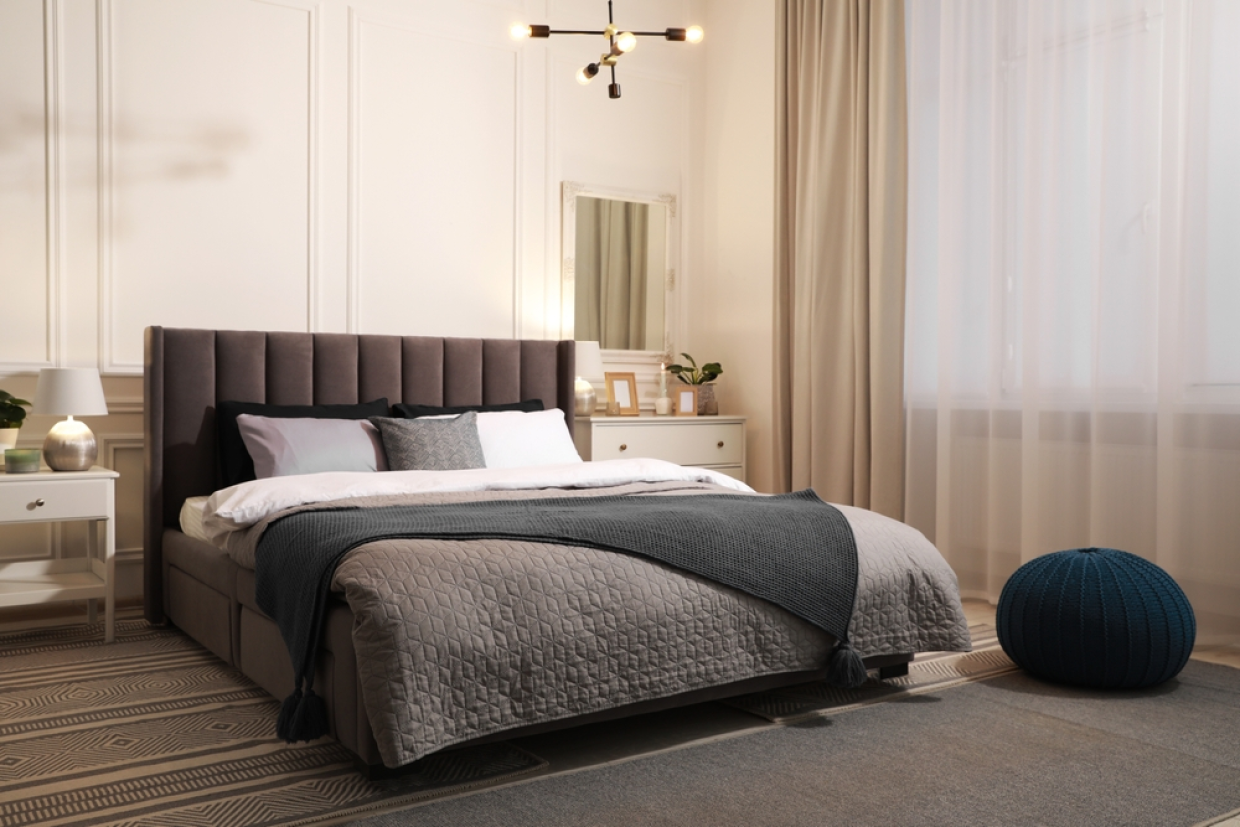Are you tired of restless nights and waking up feeling groggy? Your bed could be to blame. Choosing the right bed for your home is crucial for a good night’s sleep and overall well-being. But with so many options available, where do you start? Don’t worry, we’ve got you covered. In this blog, we will share 10 essential tips to help you find the perfect bed that suits your needs and preferences.
Imagine sinking into a plush mattress after a long day, feeling the softness enveloping your body, and drifting off to dreamland. Or perhaps you prefer the support of a firm mattress, keeping your spine aligned and relieving pressure points. We understand the importance of a good bed, and that’s why we have compiled these tips to help you make an informed decision.
Here’s a sneak peek of what we’ll be discussing:
1. Assessing your sleep needs: Everyone is unique, and understanding your sleep patterns and preferences is vital in choosing the right bed.
2. Comfort vs. support: Finding the right balance between comfort and support can make a world of difference.
3. Mattress types: From memory foam to innerspring, we will explore the pros and cons of different mattress materials.
Short Summary
- Assess your sleep needs and understand your sleep patterns and preferences before choosing a bed.
- Find the right balance between comfort and support to ensure a good night’s sleep.
- Consider the different mattress types available, such as memory foam, hybrid, innerspring, latex, and organic, and their pros and cons.
- Determine the right firmness level based on your comfort preference, whether you prefer a firmer or softer mattress.
Consider Your Sleep Position
Getting a good night’s sleep starts with choosing the right bed, and one of the crucial factors to consider is your sleep position. Different sleep positions require different levels of support and pressure relief to ensure optimal comfort and spinal alignment. Here are some important tips to help you find the perfect bed based on your sleep position:
Side Sleepers
Look for a mattress with medium firmness that provides enough cushioning to relieve pressure points on your hips and shoulders.
Consider a memory foam or hybrid mattress that contours to your body shape and offers excellent motion isolation.
Quote: “For side sleepers, it’s essential to choose a mattress that offers enough give and contouring to relieve pressure points, especially around the hips and shoulders.” Sleep Expert
Back Sleepers
Opt for a mattress that offers a balance between support and comfort, such as a medium-firm to firm mattress.
Look for a bed with good lumbar support to maintain the natural curve of your spine.
Quote: “Back sleepers typically benefit from a mattress that provides a supportive surface to keep the spine properly aligned throughout the night.” Sleep Specialist
Stomach Sleepers
Choose a firm mattress to prevent your midsection from sinking too much, which can strain your lower back.
Look for a model with reliable support to keep your spine in a neutral position.
Quote: “Stomach sleepers need a mattress that offers enough firmness and support to keep the spine aligned, preventing excessive arching or sinking.” Sleep Consultant
Combination Sleepers
Consider a medium-firm or adaptable mattress that accommodates different sleeping positions.
Look for a bed with good motion isolation to minimize disturbances when you change positions during the night.
Factors to Consider for Combination Sleepers:
Versatility: Choose a mattress that adapts to different sleep positions.
Motion Isolation: Opt for a bed that minimizes motion transfer for uninterrupted sleep.
Edge Support: Look for enhanced edge support if you tend to move around during sleep.
Getting a good night’s sleep starts with choosing the right bed, and one of the crucial factors to consider is your sleep position. Different sleep positions require different levels of support and pressure relief to ensure optimal comfort and spinal alignment. Here are some important tips to help you find the perfect bed based on your sleep position:
Side Sleepers
Look for a mattress with medium firmness that provides enough cushioning to relieve pressure points on your hips and shoulders.
Consider a memory foam or hybrid mattress that contours to your body shape and offers excellent motion isolation.
Quote: “For side sleepers, it’s essential to choose a mattress that offers enough give and contouring to relieve pressure points, especially around the hips and shoulders.” Sleep Expert
Back Sleepers
Opt for a mattress that offers a balance between support and comfort, such as a medium-firm to firm mattress.
Look for a bed with good lumbar support to maintain the natural curve of your spine.
Quote: “Back sleepers typically benefit from a mattress that provides a supportive surface to keep the spine properly aligned throughout the night.” Sleep Specialist
Stomach Sleepers
Choose a firm mattress to prevent your midsection from sinking too much, which can strain your lower back.
Look for a model with reliable support to keep your spine in a neutral position.
Quote: “Stomach sleepers need a mattress that offers enough firmness and support to keep the spine aligned, preventing excessive arching or sinking.” Sleep Consultant
Combination Sleepers
Consider a medium-firm or adaptable mattress that accommodates different sleeping positions.
Look for a bed with good motion isolation to minimize disturbances when you change positions during the night.
Factors to Consider for Combination Sleepers:
Versatility: Choose a mattress that adapts to different sleep positions.
Motion Isolation: Opt for a bed that minimizes motion transfer for uninterrupted sleep.
Edge Support: Look for enhanced edge support if you tend to move around during sleep.
Understanding Your Body Type
When it comes to choosing the right bed for your home, understanding your body type is crucial. Everyone’s body is different, and selecting a mattress that properly supports your unique physical requirements can significantly impact your comfort and quality of sleep. Here are some key factors to consider when assessing your body type and determining the best mattress for you:
Identify your sleep position
Are you a side sleeper, back sleeper, or stomach sleeper? Each position puts different pressure on your body, requiring specific support and contouring. For example, side sleepers generally benefit from a softer mattress that cushions their shoulders and hips, while back and stomach sleepers often require firmer support to keep the spine aligned.
Determine your weight distribution
Understanding how your weight is distributed across your body is another essential aspect. Heavier individuals might need a mattress with stronger support to prevent sinking too deeply, while lighter individuals may benefit from a softer mattress that conforms to their body shape more easily.
Consider any potential pain points
If you experience any specific pain points or have certain health conditions, such as back pain or arthritis, addressing those needs becomes crucial. Mattresses with targeted pressure relief and contouring properties, like memory foam or latex, can provide relief and alleviate discomfort.
Evaluate your personal preference
While considering your body type is vital, don’t overlook your personal preferences as well. Some individuals prefer a medium firmness level for a balance of support and comfort, while others might opt for a firmer or softer mattress based on their own preferences and comfort levels. It’s important to find a mattress that feels right for you.
The Importance of Mattress Type
When it comes to choosing the right bed for your home, one of the most crucial factors to consider is the mattress type (keywords: mattress type, memory foam, hybrid mattress, innerspring mattress, latex mattress, mattress topper, organic mattress, hybrid model). The mattress type plays a vital role in determining the comfort, support, and overall sleep experience you can expect. Different mattress types offer unique benefits and are suitable for different individuals based on their preferences, body type, and sleep positions.
Memory Foam Mattresses
Memory foam mattresses are known for their exceptional contouring properties, which provide personalized support by conforming to your body shape. These mattresses are excellent for relieving pressure points and reducing motion transfer, making them an ideal choice for light sleepers or individuals who share a bed with a partner.
Innerspring Mattresses
Innerspring mattresses are constructed with a core of steel coils that offer strong support and durability. These mattresses are known for their excellent breathability and responsiveness. They provide a bouncy feel and are ideal for individuals who prefer a firmer surface or those who tend to sleep hot.
Latex Mattresses
Latex mattresses are made from natural or synthetic latex material. They provide a unique combination of comfort, support, and responsiveness. Latex mattresses are hypoallergenic, resistant to mold and dust mites, and offer excellent durability. If you prefer a mattress that is environmentally friendly and has a great balance of support and bounce, a latex mattress could be an excellent choice.
Hybrid Mattresses
Hybrid mattresses (keywords: hybrid mattress, best of both worlds) combine the benefits of different mattress types by incorporating layers of memory foam, latex, or other materials with a core of innerspring coils. These mattresses offer a blend of support, pressure relief, and responsiveness. Hybrid mattresses are suitable for a wide range of sleepers and can accommodate varying body types and sleep preferences.
Mattress Toppers
If you already have a mattress that you love, but it lacks certain qualities such as pressure relief or support, you can consider adding a mattress topper to enhance its comfort level. Mattress toppers come in various
Finding the Right Firmness Level
When it comes to choosing the right bed for your home, one of the most crucial factors to consider is the firmness level. The firmness of a mattress can greatly impact your comfort and support while you sleep. But with so many options available in the market, how do you determine the right firmness level for you? Here are some essential tips to help you make the best choice:
Understand Your Sleep Position
Consider your preferred sleep position when deciding on the firmness level. Each position requires different support. For example, side sleepers usually benefit from a softer mattress that cushions their shoulders and hips, while stomach sleepers may find a firmer mattress more comfortable for maintaining proper spinal alignment.
Consider Your Body Type
Your body type can also influence the ideal firmness level for you. Lightweight individuals may prefer a softer mattress to ensure sufficient contouring and pressure relief, while heavier individuals often require a firmer mattress for optimal support and stability.
Take Personal Preference into Account
While there are guidelines based on sleep positions and body types, ultimately, personal preference plays a significant role in determining the right firmness level. What feels comfortable to one person may not be the same for another. Therefore, it’s essential to try out different mattresses and assess how they feel to find the perfect fit for you.
Consult Mattress Reviews and Ratings
Online reviews and ratings can provide valuable insights into the firmness levels of various mattress brands and models. Reading about other customers’ experiences can help you gauge how a particular firmness level might suit your needs.
Test In-Store or Utilize Online Trials
Whenever possible, test different mattresses in-store to get a firsthand experience of their firmness levels. Lie down on them for a few minutes to assess the comfort and support they offer. If in-store testing is not feasible, take advantage of online mattress trials, which allow you to try out the mattress in your own home for a specific period.
Understand Mattress Types
Different mattress types, such as memory foam, hybrid, innerspring, and latex, offer varying degrees of firmness. Familiarize yourself with the characteristics and benefits of each type to make an informed decision.
Consider Motion Isolation
If you share your bed with a partner and their movements tend to disturb your sleep, choosing a mattress with excellent motion isolation can be crucial. Some mattresses are designed to minimize motion transfer, ensuring a peaceful
Factors to Consider for Comfort
When choosing the right bed for your home, comfort should be at the top of your priority list. After all, a good night’s sleep is vital for your overall well-being and productivity. Here are five key factors to consider to ensure utmost comfort when selecting a bed:
Mattress Type
The type of mattress you choose plays a significant role in determining your comfort level. There are various options available, such as memory foam, innerspring, latex, and hybrid mattresses. Each type offers distinct characteristics that cater to different sleep preferences. For example, memory foam mattresses are known for their body-contouring properties, while innerspring mattresses provide a more traditional and responsive feel.
Firmness Level
Your personal preference and sleeping position are crucial factors in determining the ideal firmness level for your bed. Side sleepers often prefer a softer mattress that can cushion their shoulders and hips, while back and stomach sleepers tend to opt for a firmer surface to maintain proper spinal alignment. Consider your body type, weight distribution, and any specific needs you may have to select the appropriate firmness level.
Motion Isolation
If you share your bed with a partner, motion isolation becomes an important consideration. Look for a bed that minimizes motion transfer, allowing you and your partner to enjoy uninterrupted sleep. Memory foam and hybrid mattresses with individually wrapped coils are known for their excellent motion isolation capabilities.
Support and Pressure Relief
A good bed should provide adequate support to keep your spine aligned throughout the night. Look for a mattress that offers strong support, especially in the lumbar region. Pressure relief is also essential, particularly if you experience aches and pains. Memory foam and hybrid models often excel in providing both support and pressure relief.
Trial Period and Warranty
To ensure your comfort, it’s essential to choose a bed that comes with a generous trial period and warranty. Look for a company that offers at least a 100-night trial period, allowing you to test the bed in the comfort of your home. Additionally, a long-term warranty demonstrates a brand’s confidence in the product’s quality and durability, providing you peace of mind in your investment.
The Role of Personal Preference in Bed Selection
When it comes to choosing the right bed for your home, one crucial factor that cannot be overlooked is personal preference. Every individual has unique sleeping habits, body types, and comfort needs. Understanding and considering these elements can greatly impact your overall satisfaction and quality of sleep.
Sleeping Position
One of the primary aspects of personal preference is your preferred sleeping position. Different mattresses cater to varying sleep positions, such as back sleepers, side sleepers, and stomach sleepers. Each position requires a specific level of support and pressure relief. For instance, side sleepers often prefer mattresses that offer ample cushioning to alleviate pressure points on their hips and shoulders.
Firmness Level
The firmness of a mattress is another personal preference that varies from person to person. Some individuals prefer a softer mattress that allows for sinking and contouring, while others prefer a firmer surface that provides more support. It is essential to assess your comfort level and find a mattress with the appropriate firmness to ensure a restful sleep.
Mattress Type
There are various types of mattresses available, including memory foam, latex, innerspring, hybrid, and more. Each type has its own unique characteristics and benefits. Memory foam mattresses, for example, are known for their body-conforming properties, while innerspring mattresses offer excellent support and bounce. Considering your personal preference and sleeping needs will help you determine the most suitable mattress type.
Motion Isolation
If you share your bed with a partner or have a tendency to toss and turn during the night, motion isolation becomes an important consideration. Some mattresses, such as memory foam and hybrid models, excel in isolating motion, ensuring that you won’t be disturbed by your partner’s movements. On the other hand, traditional innerspring beds may transfer more motion across the surface.
Specific Needs
People with specific needs, such as those with allergies or back pain, should also consider their individual requirements when selecting a bed. For individuals with allergies, an organic mattress made from hypoallergenic materials may be the best choice. Those with back pain might find a mattress with strong support and targeted pressure relief to be more suitable.
Considering Your Budget and Black Friday Deals
When it comes to choosing the right bed for your home, your budget plays a crucial role. It’s important to have a clear idea of how much you’re willing to spend before starting your search. Keep in mind that a bed is a long-term investment in your comfort and sleep quality, so it’s worth allocating a reasonable budget.
Here are some key considerations to keep in mind when thinking about your budget:
Research Black Friday Deals
Black Friday is a great time to snag some amazing deals on mattresses and beds. Many retailers offer significant discounts during this time, allowing you to get a high-quality bed at a fraction of the original price. Keep an eye out for special offers and promotions leading up to Black Friday, as well as Cyber Monday deals.
Set Your Price Range
Determine the upper limit of your budget based on your financial circumstances. Consider how much you’re comfortable spending, and try to strike a balance between quality and affordability. Remember, the goal is to find the best bed for your needs without breaking the bank.
Compare Different Brands and Models
Take the time to research and compare different brands and models within your price range. It’s important to read reviews, check customer feedback, and assess the overall reputation of the brands you’re considering. Look for beds that offer the best value for your money, with a strong emphasis on quality materials and craftsmanship.
Consider Long-Term Costs
While upfront costs are important, don’t forget to consider long-term costs associated with your chosen bed. For instance, some beds may require additional accessories like mattress toppers or specialized bedding. Look for beds that are durable and require minimal maintenance, as this can save you money in the long run.
Take Advantage of Trials and Warranties
Many bed manufacturers offer trial periods and warranties to give customers peace of mind when making a purchase. Take advantage of these offers to ensure that you’re completely satisfied with your chosen bed. If it doesn’t meet your needs, you can often return or exchange it within a specified timeframe.
We want to highlight that while it’s important to consider your budget, don’t solely focus on the price tag. The quality, comfort, and durability of the bed should also be taken into account. Finding the right balance between cost and quality will ensure that you make a sound investment in your sleep health.
Standard Sizes and Bed Measurements
Standard bed sizes and measurements are an essential consideration when choosing the right bed for your home. Understanding the different standard sizes available will help you select a bed that fits well within your space and provides the comfort you desire.
Here are some key points to keep in mind:
- Twin (38 x 75 inches): The twin size bed is the smallest and most space-saving option. It is perfect for children’s bedrooms, small guest rooms, or rooms with limited space.
- Twin XL (38 x 80 inches): The twin XL size offers extra length compared to the standard twin size, making it suitable for taller individuals or those who prefer more legroom. This size is commonly found in college dormitories.
- Full (54 x 75 inches): The full size, also known as a double bed, provides more width for single sleepers or couples who prefer to sleep closer together. It is a popular choice for guest rooms and smaller master bedrooms.
- Queen (60 x 80 inches): The queen size bed is one of the most commonly used sizes. It offers ample space for single sleepers or couples and fits well in most bedrooms. It is a versatile choice that provides a balance between comfort and space.
- King (76 x 80 inches): The king size bed is the largest standard size available. It provides ample space for couples who want extra room to spread out. King beds are commonly found in master bedrooms or larger spaces.
- California King (72 x 84 inches): The California king size bed offers extra length compared to the standard king size, making it a suitable option for taller individuals. It provides ample space and is a popular choice for spacious master bedrooms.
It’s important to consider your specific needs and the dimensions of your bedroom when choosing a bed size. Measure your room and consider any additional furniture or accessories you plan to include in the space. This will help you determine the appropriate size that offers both comfort and functionality.
Researching the Best Places to Buy a Bed
When it comes to finding the right bed for your home, it’s essential to do your research and find the best places to make your purchase. Here are some valuable tips to help you navigate the process and make an informed decision:
- Online Retailers: Check out reputable online retailers that offer a wide selection of beds. These platforms often have detailed product descriptions and customer reviews, allowing you to compare different options and make a well-informed choice.
- Local Furniture Stores: Visit furniture stores in your area and try out different beds in person. This way, you can assess their comfort, size, and overall quality. Don’t be afraid to ask the sales staff for guidance and recommendations based on your specific needs.
- Specialty Mattress Stores: Consider visiting specialty mattress stores that focus solely on beds and bedding. These stores often have knowledgeable staff who can provide expert advice on choosing the right mattress for your body type and sleep preferences.
- Factory Direct: If you’re looking for a specific brand or model, consider purchasing directly from the manufacturer. This allows you to cut out the middleman and potentially get a better deal. Some manufacturers even have showrooms where you can test their beds before making a purchase.
- Secondhand Options: Don’t overlook the possibility of finding a high-quality bed at a lower price by exploring secondhand options. You can check out local classifieds, online marketplaces, or consignment stores for pre-owned beds that are still in great condition.
- Read Customer Reviews: Before making a final decision, be sure to read customer reviews and testimonials about the bed you’re interested in. Look for reviews from people with similar sleeping habits and preferences to yours, as this can provide valuable insights into the mattress’s performance and durability.
- Compare Prices: Take the time to compare prices across different retailers to ensure you’re getting the best deal. Keep in mind that bed prices can vary significantly depending on factors such as brand, materials, and additional features, so it’s essential to do a thorough price comparison.
- Consider Black Friday Deals: If you’re in no rush to purchase a bed immediately, consider waiting for major sales events like Black Friday. Many retailers offer significant discounts during this time, making it an excellent opportunity to snag a great deal on your desired bed.
- Ask for Recommendations: Seek out recommendations from friends, family, or even online communities. Personal experiences and recommendations from people.
Consulting with Experts and Testing the Bed
When it comes to choosing the right bed for your home, one essential tip is to consult with experts and take the time to test the bed before making a final decision. Here’s why this step is crucial in finding the perfect mattress:
Seek Expert Advice
Consulting with experts in the mattress industry can provide valuable insights and guidance on choosing the right bed. Professionals who specialize in sleep and mattress technology can assess your specific needs, body type, and sleep habits to recommend the most suitable options. Their expertise ensures that you make an informed decision based on your personal preferences and requirements.
Test for Comfort
Testing the bed is an indispensable part of the decision-making process. A quick lie-down in the store won’t suffice; it’s essential to spend enough time on the mattress to evaluate its comfort level thoroughly. Lie down in your preferred sleep positions and assess how the bed supports your body. Take note of any pressure points, discomfort, or lack of support. Ultimately, the best mattress is the one that feels comfortable and supportive for your specific needs.
Consider Personal Preference
Everyone has unique preferences when it comes to mattress firmness, materials, and overall feel. Some prefer a softer mattress that provides a plush, sinking-in sensation, while others opt for a firmer surface that offers more support. Testing various mattresses allows you to identify your personal preferences based on how each bed feels to you. Keep in mind that the ideal mattress should align with your individual taste and promote a comfortable and restful sleep.
Verify Motion Isolation
If you share your bed with a partner, motion isolation becomes an important factor to consider. Testing the bed with a partner can help determine whether movements on one side of the bed disturb the other person’s sleep. If the bed minimizes motion transfer and allows for a peaceful sleep environment, it’s a good indication of its suitability for couples.
Assess Support and Durability
Testing the mattress also allows you to assess its support and durability. Lie down on different areas of the mattress and pay attention to how it supports your body. A quality bed should provide even support across your body, regardless of your sleep position. Additionally, checking the mattress’s overall construction and materials can give you a sense of its potential durability.
Conclusion
In conclusion, choose the best furniture for your home is crucial for a good night’s sleep and overall well-being. By considering factors such as size, material, comfort level, and style, you can make an informed decision that aligns with your needs and personal preferences.
Additionally, researching customer reviews and seeking expert advice can provide valuable insights into the quality and durability of different bed options.
Remember, investing in a high-quality bed is an investment in your health and happiness. Don’t compromise on comfort and support just to save a few dollars.
Take the time to explore various options, test them out in person if possible, and make a decision that will benefit you for years to come. If you’re ready to transform your sleep experience and find the perfect
FAQ
-
What is the best mattress type for me?
The best mattress type for you will depend on your personal preferences and needs. Some popular options include memory foam, innerspring, latex, and hybrid mattresses. It’s important to consider factors like your sleeping position, body weight, and any specific health concerns when choosing the right mattress for you. It may also be helpful to read reviews and try out different mattresses in person before making a decision.
-
How do I choose the right bed for my sleep position?
When choosing a bed, it’s important to consider your sleep position. For side sleepers, a softer mattress with cushioning for the shoulders and hips is recommended. Back sleepers should look for medium-firm support to keep the spine aligned. Stomach sleepers may benefit from a firmer mattress to prevent sinking in and causing back pain. Consider your sleep position when testing different mattresses to find the right fit for you.
-
What factors should I consider for comfort in a bed?
Some factors to consider for comfort in a bed include the type of mattress (e.g. memory foam, innerspring, hybrid), level of firmness, support for your preferred sleeping position, and the materials used for bedding (e.g. cotton, silk, bamboo). Other factors to consider include the size of the bed, room temperature and noise levels, and any additional features such as adjustable bases or cooling technology. It’s important to also test out the bed and consider your personal preferences for comfort.
-
What body type should I consider when choosing a bed?
When choosing a bed, it is important to consider your body type. For example, if you are a heavier person, you may need a bed with more support and a thicker mattress. If you are a lighter person, a softer mattress may be more comfortable for you. Additionally, your sleeping position can also play a role in choosing the right bed. Side sleepers may prefer a softer mattress, while back sleepers may need a firmer one for proper spinal alignment. Ultimately, it is important to choose a bed that will provide the right support and comfort for your individual body type and sleeping habits.
-
What is the standard size for a bed?
The standard size for a bed is typically determined by the country in which it is sold. In the United States, the most common sizes are twin, full, queen, and king. Twin beds are 38 inches wide by 75 inches long, full beds are 54 inches wide by 75 inches long, queen beds are 60 inches wide by 80 inches long, and king beds are 76 inches wide by 80 inches long. However, there are also variations in size within these categories, so it’s important to measure your space and consider your personal preferences when choosing the right bed for your home.
-
How do I determine the right firmness level for my bed?
To determine the right firmness level for your bed, there are a few factors to consider: Your preferred sleeping position side sleepers may prefer a softer mattress, while back sleepers may need a firmer one. Your body weight heavier individuals may need a firmer mattress for proper support. Any existing back or joint pain a medium-firm mattress may be best for those with back or joint pain. Personal preference ultimately, the best firmness level for you will depend on your own comfort preferences. It may be helpful to try out different firmness levels at a mattress store or read reviews from other customers with similar preferences to guide your decision.





